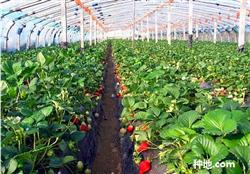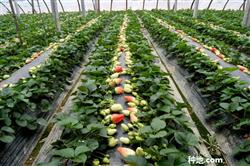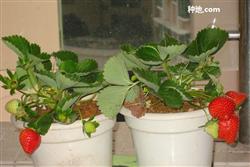How to manage strawberries in greenhouse?

How to manage strawberries in greenhouse? Please guide the greenhouse to grow strawberries. The environmental conditions of high temperature and humidity in the shed are very conducive to the occurrence of all kinds of diseases and insect pests. Therefore, strengthening the comprehensive control of diseases is the key link to realize the high and stable yield of strawberries in greenhouse. First, leaf blight is mainly harmful to leaves, petioles, fruit pedicels, tender stems and sepals. At first, purple-brown, inconspicuous and irregular spots were formed on the leaves, and then expanded into irregular spots with a length of 4mm. If more than one spot occurs on one leaf, the whole leaf is dark, and then yellowish brown and withered. There are scattered small black spots in the disease spot. The spot on the pedicel and petiole is dark brown, spotted at first, and then enlarged into strips. Prevention and control measures: timely removal of diseased leaves, old leaves. Spray 70% chlorothalonil wettable powder 500% 700 times liquid at the initial stage of the disease, spray again after 10 days, or spray 200 grams of 70% mancozeb wettable powder plus 75 kg of water per mu. Second, powdery mildew is mainly harmful to leaves, flowers, fruits, fruit stalks, petioles and stolons. When the leaves were damaged, a thin frosty powder appeared on the back of the leaves at the initial stage, and then extended to the whole plant. With the aggravation of the disease, the leaves were rolled up in the shape of a spoon; the buds and petals were damaged in purplish red, which could not bloom or bloom completely; the fruit was infected, and the fruit was covered with white powdery matter, not inflated, lanky, and the young fruit lost its luster and hardened. Prevention and control measures: in the early stage of the disease, use 2500-4000 times solution to control 2 times in time, cut leaves in the whole garden after harvest, spray 1000 times of thiophanate methyl solution or 800 times solution of 50% acetaminophen. Third, Botrytis cinerea is mainly harmful to flowers, petals, fruits and leaves. On the fruit, the disease begins from the base near the sepal, the disease spot is water-stained at the initial stage, turns brown gradually, forms a long brown disease spot, and expands gradually in the later stage, which makes the fruit soften and rot; when the flower is damaged, the petals turn brown and withered; when the pedicel and petiole are damaged, they turn brown at the initial stage, then grow gray mold, and finally rot and dry up, which seriously affects the yield. Control measures: from budding to flowering, spray with 25% carbendazim wettable powder 300 times, 70% methyl topiramate 800 times, 50% carbendazim 800 times 1000 times, and so on. In the rainy season, fumigation with "Yixunling" fumigant can be used, fumigating once every 10 to 15 days. Fourth, the plant affected by root rot starts from the lower leaves, the leaf margin turns reddish brown, gradually withered upward, and finally withered. Control measures: before transplanting strawberries were irrigated with 40% asparagus green powder 600 times, then covered with soil and transplanted. Fifth, the aboveground parts of the plants susceptible to Verticillium wilt grow poorly. The main symptoms of the disease are deformed young leaves, narrow and boat-shaped leaves, yellow leaves, rough and dull surfaces, and leaf edges turn brown and wither inward until death. Control measures: the implementation of crop rotation, the strict introduction of disease-free plants; shorten the renewal life; the diseased plants must be pulled out and burned. Before transplanting strawberries were sterilized with 40% asparagus green powder 600 times or 70% methyl topiramate 700 times. 6. the plants infected by virus disease showed dwarfing, smaller leaves, sharp serrated leaflet edges, yellowing of heart leaves, early flowering, smaller fruits, lower yield and less stolons. Control measures: select virus-free seedlings, rotate virus-free seedlings once in 2 ~ 3 years, and strengthen aphid control at the same time. Attention should be paid to strengthening agricultural prevention and control on the basis of chemical control. Timely ventilation to reduce humidity in the greenhouse, strengthen fertilizer management, cultivate strong plants, advocate rotation, select virus-free seedlings, open deep drainage ditches around the shed, ensure rain stop ditch dry, timely pull out diseased plants, remove diseased leaves, old leaves and diseased fruits, etc. Click to get more strawberry planting techniques click to get more fruit planting techniques
- Prev

What is the principle of fertilizing strawberries?
What should the greenhouse strawberries pay attention to during the flowering and fruiting period? Please introduce the strawberry flower and fruit period to pay attention to the following points: first, after spraying gibberellin buckle shed heating, when the plant grows 1-2 young leaves, spray 10-20 × 10-6 gibberellin, each plant spray 5 ml solution, an interval of 1 week, according to the growth strength can be sprayed 2-3 times to promote growth and development. ...
- Next

How do you plant strawberries?
How do you plant strawberries? Please guide strawberry potted plants to refer to the following methods: first, select pots, soil and varieties. It is appropriate to choose ceramic pots with a diameter of 20-30 cm in pots. The basin soil is selected with high humus content. The varieties use European four Seasons Red, Changhong 2, 83-38 and other excellent four Seasons Strawberry varieties.
Related
- Moge, come on! The staff of the peasant association in the producing area of cantaloupe were frightened when the crowd gathered.
- Causes and Solutions of low Fruit setting rate of Apple
- Symptoms and control measures of passion fruit virus disease
- Fruit growing lesson: how do apple orchards keep high yields?
- Can you build orchards in the mountains? What are the pros and cons?
- How to manage the coloring period of Crisson grape?
- This paper introduces the processing technology of two kinds of fig products.
- How much is a month for retired teachers in rural areas by 2020?
- How can strawberry planting increase sugar content? We should pay attention to management in many aspects.
- What are the cultivation techniques on how to improve the yield of golden fruit?

